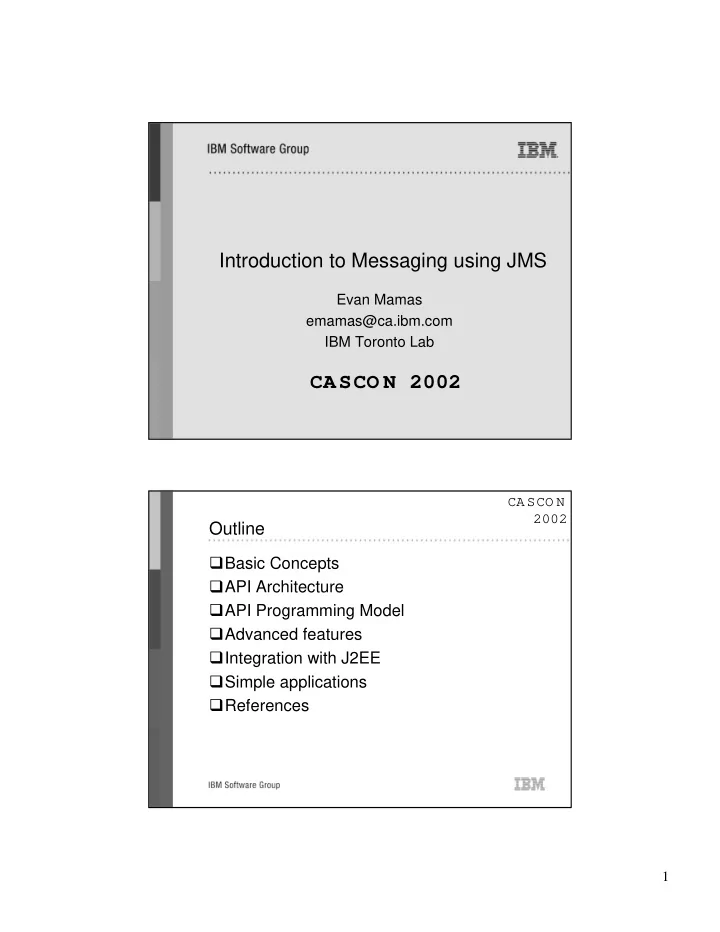

Introduction to Messaging using JMS Evan Mamas emamas@ca.ibm.com IBM Toronto Lab CASCO N 2002 CASCO N 2002 Outline � Basic Concepts � API Architecture � API Programming Model � Advanced features � Integration with J2EE � Simple applications � References 1
CASCO N 2002 Messaging � “Method of communication between software components” � Point to Point – A client can send and receive messages to and from another client – A messaging agent provides facilities for creating, sending, and receiving messages � Loosely coupled – Sender / Receiver are not required to be available at the same time – They do not have to know anything about each other CASCO N 2002 What is JMS? � Standard API for messaging – Provides access to Message Oriented Middleware (MOM) – Analogous to JDBC and DBMS � Support for distributed transactions � Integration with J2EE – Synchronous message send and receive – Message driven beans � Latest spec version is 1.1 – Part of J2EE 1.3 (1.4) 2
CASCO N 2002 Why use JMS? � JMS vs. Vendor Specific APIs – Abstraction from vendor specific APIs – Message Oriented Middleware (MOM) vendors offer similar functionality and APIs – Easy to upgrade components � JMS vs. RPC – Decoupled components • Easy to replace components of the system – Application does not require all components to be up and running – Asynchronous messaging scales better when multiple systems need to be integrated CASCO N 2002 RPC vs. JMS Ac counting Inventory Orders HelpDesk Ac counting JMS Inventory Orders S erver HelpDesk 3
CASCO N 2002 JMS Basic Concepts � Architecture – Providers, Clients, Messages � Messaging domains – Point to Point – Publish / Subscribe – J2EE implementers must support both � Message consumption – Synchronous and Asynchronous CASCO N 2002 JMS API Architecture � JMS Provider – Implements JMS interfaces – A J2EE 1.3 implementation � JMS Client – Produces and consumes messages � Messages – Multiple message formats � Administered Objects – Required by clients – Connection and destination factories � Native Clients 4
CASCO N 2002 JMS API Architecture CASCO N 2002 Point to Point Messaging domain � Message queue, sender, receiver � Clients must know which queue to use � Queue retains the message until consumed or expires � One consumer per message � No timing dependencies 5
CASCO N 2002 Point to Point Messaging domain CASCO N 2002 Publish/Subscribe Messaging domain � Topic based – Hierarchy of topics is possible � Publishers and subscribers are anonymous � Messages are retained as long as necessary to get distributed to subscribers � One message multiple consumers � Timing constraints – Messages received only after subscription – Subscriber must remain active – Durable messages 6
CASCO N 2002 Publish/Subscribe Messaging domain CASCO N 2002 Message Consumption � Synchronous – Receiver explicitly fetches the message from the queue by calling the receive method – Call can be blocking – A timeout could be used if message does not arrive in specified time � Asynchronous – Register a message listener with a consumer – onMessage method is invoked when a message becomes available 7
CASCO N 2002 JMS API Programming Model � Administered Objects � Connections � Sessions � Message Producers � Message Consumers � Messages CASCO N 2002 Administered Objects � Configured by the administrator � Usually looked up through JNDI � Connection Factories – Used by the client to create a connection with a provider – Has preconfigured parameters – QueueConnectionFactory or TopicConnectionFactory � Destination Factories – Where messages are put /read from – Point To Point: Queues – Publish/Subscribe: Topics 8
CASCO N 2002 Connections � A virtual connection with a JMS provider � Queue or Topic connections are created using the corresponding connection factory � start needs to be called before messages can be consumed � close needs to be called to release resources � stop can be used to temporarily stop message delivery without closing the connection CASCO N 2002 Sessions � Single threaded context for consuming/producing messages � Sessions are used to create message consumers, message providers, and messages � Sessions provide a context to group as one atomic operation a number of sends and receives � QueueSession and TopicSession � Can be transactional (local) � Can provide acknowledgment 9
CASCO N 2002 Message Producers � Send messages to a destination � Unidentified producers can be used when we want to specify the destination at send time � QueueSender interface – send � TopicPublisher interface – publish CASCO N 2002 Message Consumers � Receives messages sent to a destination � Message Receivers – QueueReceiver and TopicSubscriber – start and close – Used synchronously by calling the receive method � Message Listeners – QueueListener and TopicListener – Used asynchronously (onMessage) � Message Selectors – Filter messages using an SQL92 conditional expression – Only headers and properties can be filtered (not content) 10
CASCO N 2002 Messages � Header – Unique ID, timestamp, destination, priority,… � Properties (optional) � Body (optional) – TextMessage – MapMessage – BytesMessage – StreamMessage – ObjectMessage – Message (no body) CASCO N 2002 JMS API Programming Model 11
CASCO N 2002 Reliability � Acknowledgment – Client, Provider � Persistence � Priority – 0-9 (default is 4) � Expiration � Temporary destinations – Valid within the scope of a connection – Allow client to programmatically create destinations CASCO N 2002 Reliability (advanced) � Durable subscriptions � Local transactions – Using the session as the context � Distributed transactions – Container managed – Bean managed 12
CASCO N A Simple J2EE Application: 2002 Client to Message-Driven Bean 13
ERROR: ioerror OFFENDING COMMAND: %image_file_continue STACK:
Recommend
More recommend